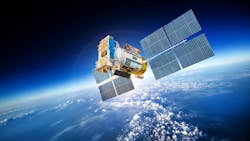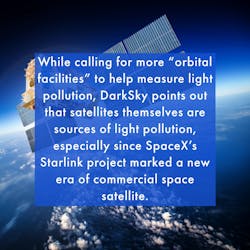DarkSky says light pollution prevention “remains extremely low”
DarkSky International has published its annual overview of artificial lighting’s effects on life on Earth. To paraphrase a central point of the report: We have a long way to go to mitigate the multifaceted harmful effects of light pollution.
“Light pollution is surging in both its presence and reach across our planet,” DarkSky says in the introduction to "Artificial Light At Night: State of The Science 2024."
The report effectively challenges vendors and users to up their game, pointing out that “scientific studies suggest the overuse of artificial light at night is the main source of light pollution yet the functional efficacy of outdoor lighting remains extremely low.”
DarkSky is a Tucson, Ariz.–based group that works to prevent light pollution, which bleaches out the view of stars and replaces dark skies with “skyglow” — created in populated areas when scattered outdoor light bounces back to Earth after hitting clouds and particles.
Its annual State of the Science report provides an update on knowledge and findings from the scientific community. Scientists base many of their dark sky observations on images from satellites and other orbiting and airborne craft, such as the International Space Station.
These “remote sensors” continue to show that light pollution is increasing, and the situation is likely worse than indicated because they do not pick up all light.
“For example, the best available satellite cameras are not sensitive to some colors of light,” DarkSky notes. “In particular, they do not see the blue light emitted by white LED lighting. This means that key light pollution indicators are probably underestimated.”
Although there have been some observations of blue light — such as by astronauts aboard the International Space Station using digital SLR cameras — by and large the instrumentation is lacking, according to DarkSky.
As such, the report urgently calls for “new, dedicated orbital facilities to address important research questions.” It points out that “this is especially true given that some Earth-observing satellite missions, such as NASA’s Terra, are slated to end in coming years.” (In fact, Terra has not been transmitting since May 11 following a solar array failure, according to NASA, which is monitoring the problem.)
The blue spectra of LED could also be a significant factor in skyglow, the report suggests. It also points out that skyglow is getting more pronounced as cloud cover becomes more common with climate change.
On a paradoxical note, while calling for more “orbital facilities” to help measure light pollution, DarkSky points out that satellites themselves are sources of light pollution, especially since 2019 when SpaceX’s Starlink project marked a new era of commercial space satellite.
As it did in its 2022 report (when the group was called the International Dark-Sky Association), DarkSky applauds the energy efficiency of LEDs compared to conventional lighting sources, but it questions whether that efficiency is lulling users into “over-lighting.”
DarkSky encourages optimal use of LED spectrum and distribution in order to cut down on overlighting on projects.
The report breaks down the harmful effects of light pollution on the night skies, on ecological systems, and on human health. It also examines artificial lighting in the context of public safety, noting that additional lights or higher light levels are not always necessary to control crime or for road safety. It also looks at illumination’s relationship to energy use, climate change, and social justice.
As light pollution increasingly gains attention, some experts have called for more consistent metrics.
DarkSky works with industry, communities, municipalities, regions, parks, and people. It runs a number of certification programs to facilitate suitable outdoor products and lighting schemes.
It is by no means alone in detecting the diminishing night skies. For just one example, last year GFZ German Research Centre for Geosciences in Potsdam reported that stars are vanishing from view faster than previously thought.
Follow our LinkedIn page for our latest news updates, contributed articles, and commentary, and our Facebook page for events announcements and more. You can also find us on the X platform.

Mark Halper | Contributing Editor, LEDs Magazine, and Business/Energy/Technology Journalist
Mark Halper is a freelance business, technology, and science journalist who covers everything from media moguls to subatomic particles. Halper has written from locations around the world for TIME Magazine, Fortune, Forbes, the New York Times, the Financial Times, the Guardian, CBS, Wired, and many others. A US citizen living in Britain, he cut his journalism teeth cutting and pasting copy for an English-language daily newspaper in Mexico City. Halper has a BA in history from Cornell University.





![The DesignLights Consortium continues to make progress in shifting outdoor lighting products and implementation practices toward a more restrained and thoughtful strategy. [Image does not represent a DLC qualified fixture.] The DesignLights Consortium continues to make progress in shifting outdoor lighting products and implementation practices toward a more restrained and thoughtful strategy. [Image does not represent a DLC qualified fixture.]](https://img.ledsmagazine.com/files/base/ebm/leds/image/2024/08/66be810888ae93f656446f61-dreamstime_m_265700653.png?auto=format,compress&fit=&q=45&h=139&height=139&w=250&width=250)
